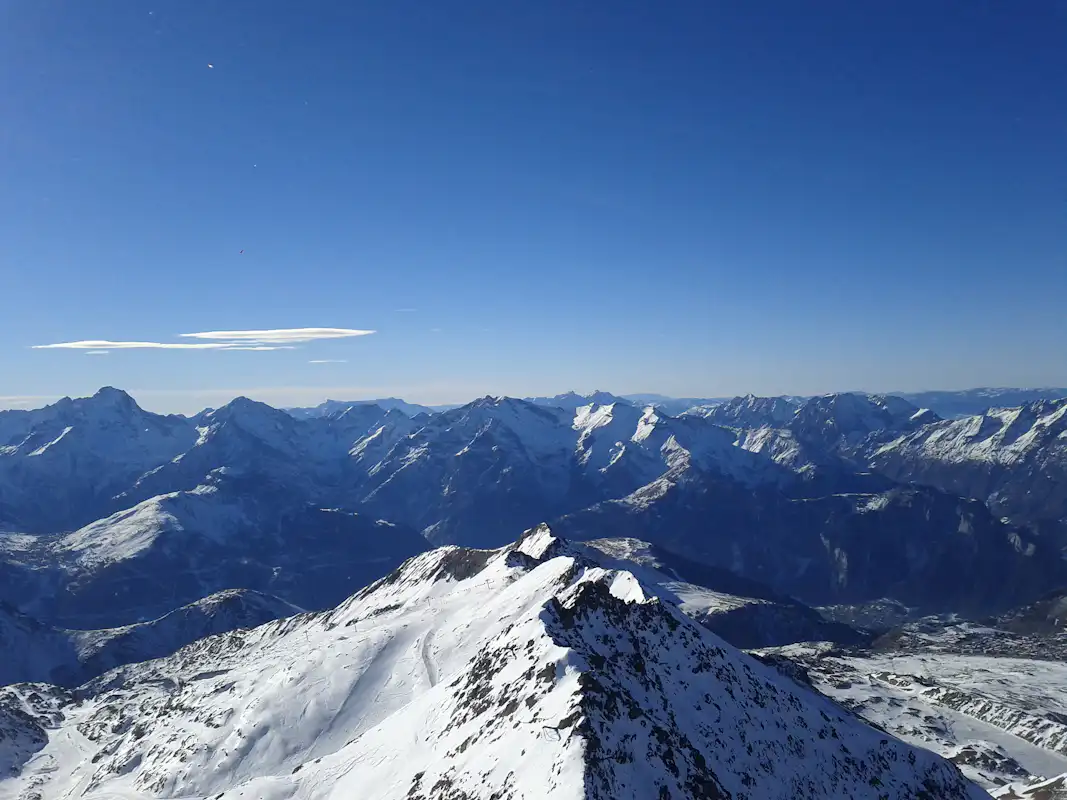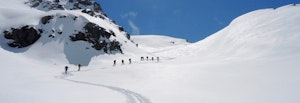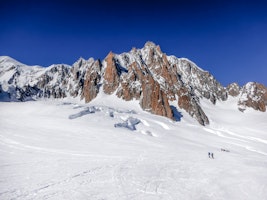Situated in a mountain pasture in the center of the French Alps, Alpe d' Huez was long hailed as one of Europe’s premier skiing destinations.
The first lifts in Alpe d' Huez were constructed in the mid-1930s, but the resort rose to fame after the 1968 Winter Olympics when the village hosted that year’s bobsledding events. Images of imposing, snow-capped peaks and long uninterrupted slopes filled newspapers and television screens around the world.
Soon avid skiers came to the village seeking alpine adventures. However, the construction of several nearby resorts in the 1970s and 80s drew many skiers away from Alpe d' Huez.
Alpe d' Huez received renewed attention as off-piste skiing gained popularity. The town is not only close to other popular off-piste spots, such as La Grave, Serre Chevalier and Les Deux Alpes, but also has many excellent destinations itself.
Three-thousand-meter-high mountains, steep couloirs and deep powder fields surround these elevated pasturelands and lend themselves to some of France’s best off-piste skiing. Expect 2**.000-plus meter vertical descents** and excellent powder throughout the season.
Coming to Alpe d' Huez provides you with a lot of freedom and versatility to plan the off-piste adventure that most suits your wants and needs. To that end, we have compiled some useful facts and information for your consideration below.
3 reasons to go skiing in Alpe d' Huez
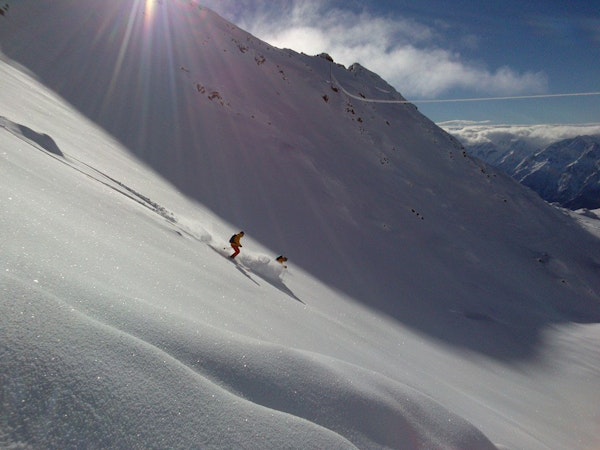
Stunning scenery
Snow-capped mountains, alpine lakes and high mountain meadows, which transform into deep powder fields in the winter, define the landscape around Alpe d' Huez. Part of what has drawn skiers to this spot for nearly a century is the excellent views you get as you plunge down its steep slopes.
The low level of development here, too, makes the entire experience more wild, which, after all is why we go off-piste skiing in the first place.
Avoid the crowds
Coming hand-in-hand with the low levels of development is less crowding. While people wait in lines at some of the other more popular resorts in the area, Alpe d' Huez offers plenty of varied off-piste spots that are not too closely located to one another. This means you’ll often have no crowded slopes to navigate and plenty of fresh powder on the slopes. Close proximity to other popular off-piste areas gives you even more options.
Plentiful powder
Snow comes to Alpes d’ Huez in November and is frequently refreshed throughout the skiing season. This is great for off-piste skiers because it means whenever you come, it will feel like you’re getting the first run of the season.
Not only is the powder plentiful, but it is excellent for off-piste skiing, allowing for incredible runs throughout the area.
Where to Go? Best Off-Piste Skiing Spots in Alpe d'Huez

1. Pic Blanc
Located just northeast of Alpe d’ Huez, Pic Blanc is chock-full of excellent off-piste runs that lead from the summit back down toward Alpes d’ Huez. There are options for skiing the other side of the peak too, but those lead to other villages.
Rising to 3.300 meters above sea level plenty of routes provide 2.000 meter vertical descents through the area’s stunning scenery.
Once you exit the gondola, there are plenty of routes that head down the southwest, west and northwest faces of the mountain. The ones that head southwest and west are generally the safest and there is no shortage of routes to choose from. These will all lead down to the Sarenne path and from here getting back to Alpe d’ Huez is a simple enough task.
The northwest face is more prone to avalanches and should never be done without a certified guide or the proper equipment. That being said, avalanches are still quite rare and there are a few excellent intermediate and advanced runs back down into the villages of Oz and Poutran.
2. Le Grand Sablat
Situated on the eastern side of Pic Blanc, the glacier at Le Grand Sablat is an unforgettable descent for experienced off-piste skiers.
After taking a lift partway up Pic Blanc, you get off and enjoy a 2.000 meter vertical descent down into the valley below. There are several different routes down the Le Grand Sablat of varying lengths and technical difficulties, but they will all take you back down to the village of Clavans.
This route is generally best tackled in the morning since it faces southeast and has a variety of snow conditions from icy and hard snow toward the top of the glacier to a mix of powder and slush farther down.
From Clavans, you will either need to skin back up the glacier to return or book a taxi from the village in advance.
You may also opt to head off the chairlift and take a different route, skiing down a little bit before heading along the contours of the Middle Col and skiing down the couloir du Sablat until you reach the terminal moraine of the glacier.
The skiing here is quite steep and thrilling, but best reserved for more advanced skiers. From the end of the moraine, you will be able to skin along the high plateau back to a ski lift and head back down into Alpes d’ Huez.
3. The Oisans Region
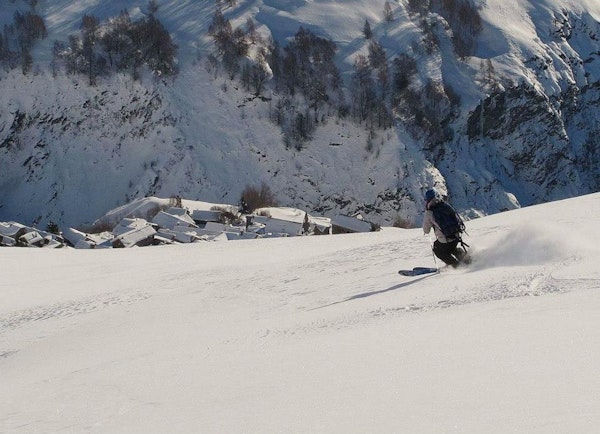
Situated within Écrins National Park, the Oisans region is a popular off-piste spot for skiers coming to Alpe d’ Huez.
In less than an hour by car, off-piste skiers can enjoy a variety of different types of skiing, such as checking out the southern slopes of Massif des Écrins and the numerous runs around the Dome de Puy Salie, among many other options.
Rather than descending to La Grave, you will head up to the usual starting point and on Massif des Écrins, generally Point Trilfide or Pic de la Grave, and head down the usual way until you reach the ridge that descends to Les Ruillans.
Instead of descending, you will skin up over the top of the ridge and then have various options to ski back down to Saint-Christophe-en-Oisans. Here you can head down the ridge, circumnavigating Aiguille du Plat de la Selle or, for a slightly longer adventure, head west directly to the Dome de Puy Salie.
If you’re looking for less driving, off-piste opportunities are also plentiful on Dome de Puy Salie. With numerous couloirs to explore, it is pretty easy to head up any lift and wind your way back down in just about any direction.
Based on your skill level and preferences, it should be pretty easy to coordinate with your guide exactly what you want to do and he or she will likely know where exactly to head in the Oisans region to meet those needs.
What is the Best Time to Go Skiing in Alpe d' Huez?
The off-piste skiing season in Alpes d' Huez runs from December to April.
Average daily temperatures during the winter months here are generally between -8 °C and -5 °C. These tend to warm a bit in the spring, rising to around -2 °C and even as high as 5 °C, at the very end of the season.
There is also plenty of snow throughout the winter and into the spring. The snow begins to fall at the end of November and blankets the slopes throughout the season. Expect between 8 and 12 snowy days each month here, with more than 100 millimeters of snow falling at a time.
How much does a guided ski trip to Alpe d' Huez cost?
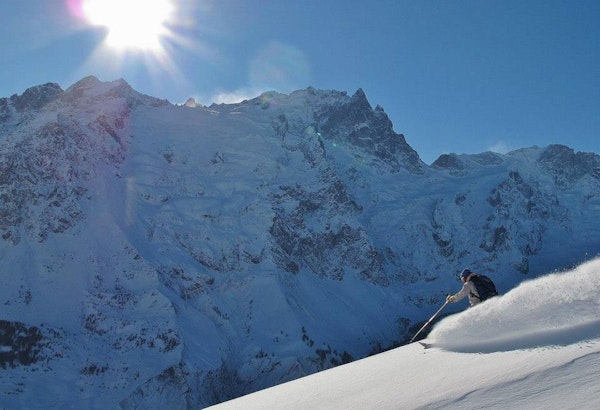
Guided off-piste skiing prices vary greatly depending on a number of factors, ranging from how many days you are headed out to ski for, how many people are in your group and what is included in the guide’s fee.
That being said, you can expect to pay a minimum of about €90 per person. This price generally is for a single-day trip and includes the guide fee and group equipment and applies to groups of four or more people. This same trip with only a person or two, however, can rise all the way up to €450.
These prices are pretty standard for a single-day guided off-piste trip. Some guides, however, offer larger group packages (usually minimum of eight people) that include the guide fee, accommodation, half-board meals and group equipment. For this kind of trip, expect to pay around €900 per person.
How to get to Alpe d' Huez?
If you are headed to Alpe d' Huez from outside of France, but within Europe then flying into the airports at Grenoble (GNB) or Lyon (LYS) would be the best options. GNB is likely to be more expensive and have fewer flight options, while LYS will likely be cheaper and haver more options throughout the season.
If you are flying from outside of Europe and then it is easier to fly into the international airport at Geneva (GVA).
From any of these airports it is then easy enough to rent a car and make the relatively short drive (1.5, 2 and 3 hours, respectively). However, if you don’t want the hassle of renting a car then public transit is also available.
From Grenoble, you can opt to take a private transfer from the airport, which will be slightly more expensive and must be booked in advance, or you can take a local bus to the main bus station in the city center and from there take line 3000 to Bourg d’ Oisans and then line 32000 to Alpes d' Huez.
From Lyon, you would be best served by taking the TER from the city’s main train station to Grenoble and take the bus on to Alpe d' Huez from there.
From Geneva, you can take the train to any of Lyon or Chambery then transfer to Grenoble by another train and take the bus on to Alpes d' Huez from there.
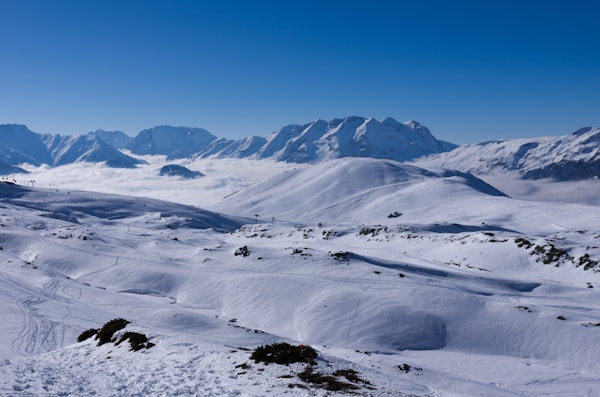
So what are you waiting for? Book your next ski holiday to Alpe d' Huez today and get ready for stunning scenery, plentiful powder and incredible off-piste adventures!
